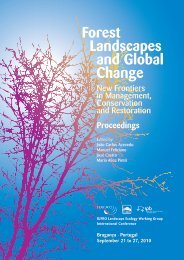Programa e Resumos - I Congresso Ibérico de Ciência do Solo 2004
Programa e Resumos - I Congresso Ibérico de Ciência do Solo 2004
Programa e Resumos - I Congresso Ibérico de Ciência do Solo 2004
You also want an ePaper? Increase the reach of your titles
YUMPU automatically turns print PDFs into web optimized ePapers that Google loves.
I <strong>Congresso</strong> Ibérico da Ciência <strong>do</strong> <strong>Solo</strong> – 15 a 18 <strong>de</strong> Junho <strong>de</strong> <strong>2004</strong>, Bragança, Portugal<br />
Evaluation of three soil test extractants for copper and iron availability in<br />
agricultural alkaline soils<br />
M.I. Rico, J. Novillo, A. Obra<strong>do</strong>r, L.M. Lopez-Valdivia & J.M. Alvarez<br />
Departamento <strong>de</strong> Química y Análisis Agrícola, Escuela Técnica Superior <strong>de</strong> Ingenieros<br />
Agrónomos, Universidad Politécnica <strong>de</strong> Madrid, Ciudad Universitaria, s/n, 28040 Madrid, Spain<br />
Tel: (34) 913 365 650 – Fax: (34) 913 365 639 – E-mail: mirico@qaa.etsia.upm.es<br />
Abstract<br />
Communication: Poster<br />
A variety of soil test extractants are used for the evaluation of micronutrient availability<br />
in soils. The nutrient concentrations measured by a specific extractant are a function of<br />
both the chemical composition of the extractant and the particular properties of the soil<br />
tested. Consequently, the nutrient concentrations measured by two different extractants<br />
in the same soil may be very different. The fact that the results obtained by different<br />
methods differ quantitatively <strong>do</strong>es not imply that they <strong>do</strong> not provi<strong>de</strong> the same<br />
interpretation, thereby leading to i<strong>de</strong>ntical nutrient recommendations.<br />
The copper (Cu) and iron (Fe) availability in typical uncontaminated soils of Central<br />
Spain characterised by their medium or high calcium carbonate content was evaluated<br />
by sampling and analyzing twenty-eight representative soils, and greenhouse cropping<br />
six of them with spring barley (Hor<strong>de</strong>um vulgare, L.). Three commonly used chemical<br />
extractants (DTPA, EDTA and 0.1 M HCl) for soil fertility evaluation were selected to<br />
measure the available metal concentration in soils. The correlation coefficients (r)<br />
between metals extracted by each extractant and the amounts removed by plants were<br />
<strong>de</strong>termined.<br />
With regard to the removal of metals from the soil samples, extractants followed the<br />
or<strong>de</strong>r: Cu, EDTA > DTPA > 0.1 M HCl and Fe, EDTA > HCl > DTPA. Significant<br />
linear relationships suitable for use as conversion equations were obtained between the<br />
soil tests applied. Both Cu and Fe phytoavailability for barley in the greenhouse study<br />
could not be predicted significantly by using empirical mo<strong>de</strong>ls with only the quantities<br />
extracted by one of the extractants, but the inclusion of a<strong>de</strong>quate soil properties (e.g.<br />
soil free carbonate and clay contents) in the regression mo<strong>de</strong>ls improved such<br />
predictions. R2 values of the obtained mo<strong>de</strong>ls ranged from 36.2 to 75.0.<br />
– 255 –
















